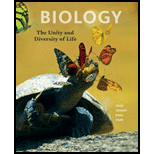
Biology: The Unity and Diversity of Life (MindTap Course List)
14th Edition
ISBN: 9781305073951
Author: Cecie Starr, Ralph Taggart, Christine Evers, Lisa Starr
Publisher: Cengage Learning
expand_more
expand_more
format_list_bulleted
Concept explainers
Question
Chapter 22, Problem 3CT
Summary Introduction
To explain: The reason that the fruit tree does not need to make as much pollen as a pine to ensure pollination.
Introduction: The arrival of pollen grains on the female reproductive part of a seed plant is called pollination. Pollination can occur through wind, insects, or animals, or through water. This increases the genetic diversity of an organism.
Expert Solution & Answer
Want to see the full answer?
Check out a sample textbook solution
Students have asked these similar questions
The Dodder plant is famous for strangling other plants. Explain how tropisms are used in the plant.
Roses have open petals while other plants such as dog tails don't. Explain how the structure and shape of different species of plants affect their pollination.
Many flowers have both anthers and pistils. What prevents self-pollination and later self-fertilization?
Look at the flower, observe color, size of petals and height of stamen and pistil.
What type of pollination does it present?
- Self pollination
- wind cross pollination
- bird cross politicization
Chapter 22 Solutions
Biology: The Unity and Diversity of Life (MindTap Course List)
Ch. 22 - The first land plants were ___ . a. gnetophytes b....Ch. 22 - Prob. 2SQCh. 22 - A waxy cuticle helps land plants ___ . a. oonserve...Ch. 22 - True or false? Ferns produce seeds inside sori.Ch. 22 - ___ attach mosses to soil. a. Rhizoids b. Rhizomes...Ch. 22 - Bryophytes alone have a relatively large ___ and...Ch. 22 - Club mosses, horsetails, and ferns are ___ plants....Ch. 22 - Coal consists primarily of compressed remains of...Ch. 22 - Insect-Assisted Fertilization in Moss Moss sperm...Ch. 22 - Prob. 2DAA
Ch. 22 - Prob. 3DAACh. 22 - The sperm of swim to eggs. a. mosses b. ferns c....Ch. 22 - A seed is a(n) ___ . a. female gametophyte b....Ch. 22 - Prob. 11SQCh. 22 - Which angiosperm lineage includes the most...Ch. 22 - Match the terms appropriately. ____ bryophyte a....Ch. 22 - Match the terms appropriately. _____ovule a....Ch. 22 - Place these groups. in order of their appearance...Ch. 22 - Early botanists admired ferns but found their life...Ch. 22 - Prob. 2CTCh. 22 - Prob. 3CTCh. 22 - Compared to vascular plants, bryophytes arc more...Ch. 22 - Lignin and vascular tissue first evolved in...
Knowledge Booster
Learn more about
Need a deep-dive on the concept behind this application? Look no further. Learn more about this topic, biology and related others by exploring similar questions and additional content below.Similar questions
- Why would wind pollinated plants produce flowers before leaves?arrow_forwardWhich statement about wind-pollinated plants is correct? Their stamens and stigmas are inside the flower and, compared to insect-pollinated plants, they have large petals Their stamens and stigmas are outside the flower and, compared to insect-pollinated plants, they have small petals Their stamens and stigmas are outside the flower and, compared to insect-pollinated plants, they have large petalsarrow_forwardA fruit farm collected information on the fruit formed by three types of pollination on their farm over one year. The resulting data is shown in the graphs. Fruit pollination đdata 3.0 1.8 2.5 1.6- 2.0 1.5 1.4 250 1.2- 200 0.8- 150 0.4 ΚΕY artificial pollination open pollination (bees, other insects and wind) pollination by bees only After considering the data in the graphs and other factors, the decision was made to use 100% artificial pollination on the farm. Justify this decision in relation to the data provided and your understanding of artificial pollination. number of seeds per fruit fruit mass (g) average diameter (cm) (su) sseu pɔsarrow_forward
- Describe the characteristics you would expect to find in flowers that are pollinated by the wind, beetles, bees, and hummingbirds, respectively.arrow_forwardExplain why there are different-colored flowers.arrow_forwardDescribe the method of seed dispersal of the fruit & seeds in the picture below. The more detailed you are the higher the points you can earn.arrow_forward
- Which of the following is true of pine pollen/pollination? The male gametophyte is the fully developed seed Many pollen grains have "air bladders" Pines are wind pollinated Pollen grains are composed of one cellarrow_forwardThe stigma is the opening in a flower through which pollen moves to fertilize the eggs . Which characteristic would be most helpful to the stigma in capturing pollen ? ANSWER CHOICES ARE IN THE PHOTO. thanks.arrow_forwardMost wind pollinated flowering plants have incospicuous non-fragrant flowers. How might nature be affected if all flowers were that way?arrow_forward
arrow_back_ios
SEE MORE QUESTIONS
arrow_forward_ios
Recommended textbooks for you

 Biology Today and Tomorrow without Physiology (Mi...BiologyISBN:9781305117396Author:Cecie Starr, Christine Evers, Lisa StarrPublisher:Cengage Learning
Biology Today and Tomorrow without Physiology (Mi...BiologyISBN:9781305117396Author:Cecie Starr, Christine Evers, Lisa StarrPublisher:Cengage Learning Biology (MindTap Course List)BiologyISBN:9781337392938Author:Eldra Solomon, Charles Martin, Diana W. Martin, Linda R. BergPublisher:Cengage Learning
Biology (MindTap Course List)BiologyISBN:9781337392938Author:Eldra Solomon, Charles Martin, Diana W. Martin, Linda R. BergPublisher:Cengage Learning


Biology Today and Tomorrow without Physiology (Mi...
Biology
ISBN:9781305117396
Author:Cecie Starr, Christine Evers, Lisa Starr
Publisher:Cengage Learning

Biology (MindTap Course List)
Biology
ISBN:9781337392938
Author:Eldra Solomon, Charles Martin, Diana W. Martin, Linda R. Berg
Publisher:Cengage Learning
Plant Reproduction in Angiosperms; Author: Amoeba Sisters;https://www.youtube.com/watch?v=HLYPm2idSTE;License: Standard YouTube License, CC-BY